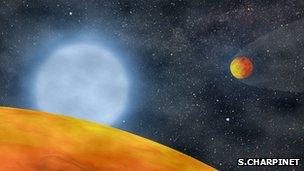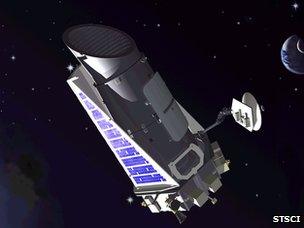Newly found planets are 'roasted remains'
- Published

An artist's impression of the two planets circling close to their parent - a former red giant star
Just a day after announcing the discovery of the first Earth-size planets ever detected outside our Solar System, scientists have confirmed the existence of two even smaller worlds.
There is something very unusual about these objects, however.
It appears they are the roasted remains of planets that spent a period of time inside the outer layers of their star.
Scientists tell Nature magazine, external that these worlds are therefore likely to have been much bigger in the past.
Once again, these worlds were identified using data from Nasa's Kepler telescope, which was put in orbit in 2009 with the specific goal of hunting down small planets.
This latest haul was detected around a star known as KIC 05807616. They have diameters that are just 76% and 87% of that of Earth.
What is interesting about this star is that it is a former red giant, a so-called "hot B subdwarf".
Red giant refers to a late phase in a star's life when it has begun to exhaust its hydrogen fuel.
Deep spiral
A star in this phase will expand, its outer layers will cool and it will glow a more reddish colour. Our own Sun will go through this phase in a few billion years' time.
But the consequence is that any planets that happen to be orbiting relatively close to the star will likely be engulfed in its expanding envelope of gas.
This will happen to the Earth and it appears to have been the case with the newly detected planets named KOI 55.01 and KOI 55.02, which whip around their host star in just a matter of hours.

The Kepler telescope was put in orbit in 2009
Their presence so close to KIC 05807616 is a tell-tale for what must have happened to them.
Going into the expanding outer layers of a star would have severely eroded the worlds, ripping away any gaseous or liquid material.
What the team sees in its data are probably just the remnant cores of what were once giant gas planets not unlike our own Jupiter.
"The details of all this are of course uncertain and would require dedicated modelling but we expect that, due to friction and tidal dissipation, the engulfed planets must have spiralled in even deeper inside the star," said lead researcher Stephane Charpinet from Toulouse University, France.
"In the process, their volatile layers have probably been evaporated or pulled away by the friction.
"At the same time, the envelope of the star may have expanded further and accelerated its rotation due to this inward motion of the planets.
"Then, the system may have stabilised into a common envelope configuration, where the planets settle on stable orbits inside the red giant," he told BBC News.
"The red giant envelope was ultimately expelled almost completely due to increased mass loss, leading to the formation of the hot subdwarf B star that we have observed."

The discovery was made while the scientists were engaged in asteroseismology - the practice of studying a star's pulsations to gauge its inner structure. It is akin to seismology which studies the interior of the Earth from the oscillations in rock generated by earthquakes.
But as they were doing this, Charpinet and colleagues noticed a characteristic dip in the light coming from KIC 05807616 every 5.76 and 8.23 hours - the result of two objects passing in front of the star as viewed from Kepler.
What seems remarkable is that the planets were not completely destroyed in the process of engulfment. But Dr Charpinet said that the large iron cores of giant planets could resist the environment for millions of years.
"Iron is certainly much harder to evaporate than the gaseous or liquid layers made of volatile elements that make the large envelopes of giant planets," he explained.
"Moreover the dense cores are quite tightly bound by their own gravity. Then, it will take more time to completely evaporate them.
"In fact our discovery suggests that such cores could survive long enough throughout the red giant phase and later on around a very hot star."
On Tuesday, a separate team announced that they had used Kepler to detect planets with diameters just 87% and 103% of that of the Earth. These go into the record books as the first true Earth-size planets found outside our Solar System.
- Published20 December 2011
- Published5 December 2011
- Published23 November 2011
- Published3 February 2011
- Published2 February 2011